Brief introduction of Yegashev Edido small Farmer in Ethiopia: taste and Flavor of Duluo G1 Sun

Professional coffee knowledge exchange More coffee bean information Please pay attention to coffee workshop (Weixin Official Accounts cafe_style)
Those who have a rough understanding of coffee history know that Ethiopia is not only the birthplace of coffee, but also the holy land in the eyes of bean hunters and the treasure house of coffee genes. Among the thousands of coffee trees born in Ethiopia, only "Typica" and "Bourbon" have opened branches and leaves all over the world, creating a thriving fine coffee industry.
Yerga Shefi has a very recognizable citric acid flavor and is the best choice for fine coffee into the pit. Ethiopia's beans, however, vary in size, appearance, and degree of roasting, leading many to define them as defective beans.
Ethiopian beans generally vary in size and are significantly less uniform. Whether it is Yega Shefi or Sidama, whether it is washed or sun-dried, sometimes the same batch of coffee beans can be observed to have significantly different roast colors and particle sizes.
Unlike traditional Ethiopian farmers, who depend on water washing plants to buy red fruits, they cannot participate in the complete green bean processing process themselves. The Smallholder Program offers:
1. Farmers loan funds
2. Build your own African solar trellis
3. Farmers are solely responsible for the coffee berries in their harvest
Under such a system, farmers are provided with better incentives and production mechanisms to produce high-quality Ethiopian sun-dried green beans.
For raw bean purchasers, regular cup test discussions and experience exchanges with small farmers every year can also help farmers in Ethiopia to understand more consumer customers 'hobbies, and such interactive methods bring many positive changes, breaking the traditional trading mode in the past-farmers are almost hidden behind the field and have no participation in the trading process.
Ethiopia Yirgacheffe Idido Tilahun Dulo G1 Natural
Country: Ethiopia Region: Idido, Gedeo Zone, Yirgacheffe Altitude: 1800-2300 m
Treatment: Sunlight Grade: G1 Variety: Native Flavor Description: Red berry, longan, almond milk tea, apricot, strawberry, Body firm, bright acid
The small farmer Duro in Yegashev, Gedeo, Iddo, with 11 family members and 65 employees, processes coffee cherries and exports about 17800 kg of coffee per year. The soil in this area is fertile reddish-brown soil. The harvest time is from October to December. During the harvest process, only fully ripe red cherries are harvested. After picking out coffee cherries with lower density in the water tank, they are placed on the trellis for sun exposure. They are turned regularly. At night, coffee cherries will be covered. The sun exposure process will be completed until they are completely dry.
The Duro family is currently facing challenges in coffee production due to price fluctuations and low market demand, and hopes to increase market competitiveness by expanding coffee farms and improving farm management.
Important Notice :
前街咖啡 FrontStreet Coffee has moved to new addredd:
FrontStreet Coffee Address: 315,Donghua East Road,GuangZhou
Tel:020 38364473
- Prev

Introduction to Kenyan washed Coffee at La Cruz Holy Cross Manor in Tarazu, Costa Rica
Professional coffee knowledge exchange more coffee bean information please follow the coffee workshop (Wechat official account cafe_style) this introduction of the "La Curz Holy Cross Manor" run by the Zamora Picado family, the Zamora Picado family has been engaged in coffee-related business since 1970, until 2014, two brothers in the family, Esteban and Felipe, decided to set up a coffee processing factory, "La Cr."
- Next

Yega Snow Fruit Tintin Farmer in Ethiopia: the quality and Flavor of Hepia G1 Solar
For more information on coffee beans, please follow the Coffee Workshop (Wechat official account cafe_style) Guotingding Cooperative, located in the Waka producing area at the southeast end of Yega Sheffield, which was originally part of the Waka Cooperative of YCFCU of the Yega Sheffei Alliance. But later, with the pursuit of traceability of raw coffee beans, independent "single producing areas" were completed.
Related
- Detailed explanation of Jadeite planting Land in Panamanian Jadeite Manor introduction to the grading system of Jadeite competitive bidding, Red bid, Green bid and Rose Summer
- Story of Coffee planting in Brenka region of Costa Rica Stonehenge Manor anaerobic heavy honey treatment of flavor mouth
- What's on the barrel of Blue Mountain Coffee beans?
- Can American coffee also pull flowers? How to use hot American style to pull out a good-looking pattern?
- Can you make a cold extract with coffee beans? What is the right proportion for cold-extracted coffee formula?
- Indonesian PWN Gold Mandrine Coffee Origin Features Flavor How to Chong? Mandolin coffee is American.
- A brief introduction to the flavor characteristics of Brazilian yellow bourbon coffee beans
- What is the effect of different water quality on the flavor of cold-extracted coffee? What kind of water is best for brewing coffee?
- Why do you think of Rose Summer whenever you mention Panamanian coffee?
- Introduction to the characteristics of authentic blue mountain coffee bean producing areas? What is the CIB Coffee Authority in Jamaica?

